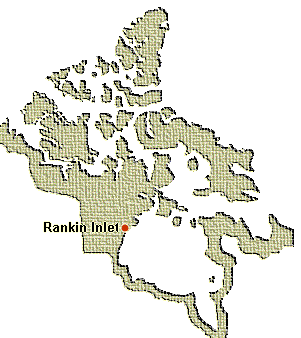Rankin Inlet ᑲᖏᖅᓖᓂᖅ
Notre Dame Du Cap
Foundation of the Roman Catholic Mission
Lay Missionary

In November 1999 Rankin Inlet welcomed a lay missionary - Fabienne Theytaz, from Switzerland. At the end of some studies (theology), instead of going back to her homeland she went to Churchill, where she learned English and worked at the Eskimo Museum. Later on this year Sr. Vicky met her in Rankin for some training in pastoral work. That’s how Fabienne described her first years in this community: “My role in the parish has been so far to keep it alive in the time of loss and big change (Sr. Vicky passed away in 2000, and Fr. Georges Lorson OMI in 2001; both were working together in Rankin for more than 20 years), and to support local leaders in church activities (Sunday school, youth group, prepararion to sacraments, visits to the sick, communion services etc.). But the biggest part of my time is spent in sharing the daily life of the people in Rankin: visits, voluntary work , fishing, berries picking etc. And also French courses and translations for the diocesan Eskimo Magazine”.
Oblates That Served the Parish:
- Fr. Robert Paradis, 1957-59, 1972
- Fr. Bernard Fransen, 1969-1971
- Fr. Théophile Didier, 1961-1963, 1966
- Fr. Julien-Marie Cochard, 1962
- Fr. Charles Choque, 1963-66, 1966-74 (provincial)
- Br. Lucien Parent, 1963-1967
- Fr. Jean-Marie Trébaol, 1965-1966
- Fr. Rogatien Papion, 1966-69, 2001
- Fr. Marcel Rio, 1970
- Fr. Joseph Leverge, 1971-1975
- Fr. Georges Lorson, 1958-60, 1975-2001
- Fr. Joseph Meeus, 2001-present
About the Town:

Rankin Inlet, located on the western shore of Hudson Bay, is the second largest community of Nunavut and communication center for the Kivalliq Region. It’s Inuktituk name, Kangiqtlinik means “deep bay or inlet”.
As for the history of the area, it was marked by the contacts of the Inuit with American and European whalers, arriving in Hudson Bay in the mid - 1800s. The Marble Island, about 40 miles from Rankin, contains the archeological remains of the whaler’s winter camps.
The area was of course often visited by the Inuit hunters, but permanent settlement developed only in 1950s, when North Rankin Nickel Mines begun to operate and many Inuit worked at the mining camps. When production stopped in 1962 government thought of closing the community, but after negotiations with the local Inuit the decision was made to keep it open. The second period of good job opportunities for the people begun when Rankin became a regional center for the government of the Northwest Territories, in 1970s. In 1990s the town was also a more important political center for the land claims organizations and a candidate for the capital of Nunavut, new Canadian territory since 1999.
According to the estimates from the year 1999 Rankin is a large community counting 2230 inhabitants.
[If you are looking for further general information about the town, a good place to visit is The 2004 Nunavut Handbook .]

